Oil & Energy
Nigerians Can Generate Electricity From Sewage Water – Scientist
An Associate Professor,
Industrial Bio-chemistry and Bio-Processes, Federal University of Technology (FUT), Minna, Dr Egwin Evans, on Wednesday said the country could generate electricity from sewage water from homes.
Evans told newsmen in Abuja that Nigerians could generate enough electricity for their household use from their sewage tanks.
According to him, this can be achieved through green technology where sewage water with the introduction of some micro organisms can be transformed into power to generate electricity.
“Normal micro organisms from the sewage tanks can generate electricity for your house and when that is done the waste can then be converted to organic fertiliser,’’ he said.
He said the innovation if harnessed would solve the problem of inadequate power supply and waste management in the country.
The scientist, who described the technology as being safe, called on Nigerians to key into the innovation.
He solicited partnership between FUT Minna and private electricity companies to commercialise the innovation to address the power challenge in the country.
Evans said the institution had also produced ethanol for cooking stoves from Water Hyacinth.
“ Water hyacinth is a huge problem for us in Nigeria. It is a plant, sometimes it causes nuisance in our waterways and people cannot move.
“What we now do is to harvest and harness this plant and convert it to ethanol for cooking stoves.
“With this we have solved three problems of clearing the waterways, generating fuel for domestic use and the residue is converted to organic waste,’’ he said.
He said the technologies could be popularised for the benefit of the citizens through training and capacity building for young scientists who would then generate electricity and ethanol independently. Evans urged the government to encourage scientists with such discoveries by linking them with interested commercial investors to fund the project.
An Assistant lecturer, Mechanical Engineering FUT Minna, Mr Lawal Sadiq said that a mobile science laboratory that would aid practical science class delivery in secondary schools had been discovered.
Sadiq said the mobile lab, which was in form of a table, had all the components of a conventional lab that could be rolled into a classroom for easy access by students.
He said the equipment enables students to understand practical subjects with little efforts. According to him, the lab can serve for all science subjects ranging from biology, agriculture, chemistry and physics. Sadiq called for the commercialisation of the mini-lab by government to create jobs for graduating students, adding that the innovation would assist all secondary schools in the country in their science practical.
The Tide reports that the innovations were on exhibition at the 3rd National Education Exhibition which was held in Abuja on Monday and Tuesday.
Oil & Energy
FG Woos IOCs On Energy Growth
The Federal Government has expressed optimism in attracting more investments by International Oil Companies (IOCs) into Nigeria to foster growth and sustainability in the energy sector.
This is as some IOCs, particularly Shell and TotalEnergies, had announced plans to divest some of their assets from the country.
Recall that Shell in January, 2024 had said it would sell the Shell Petroleum Development Company of Nigeria Limited (SPDC) to Renaissance.
According to the Minister of State for Petroleum Resources (Oil), Heineken Lokpobiri, increasing investments by IOCs as well as boosting crude production to enhancing Nigeria’s position as a leading player in the global energy market, are the key objectives of the Government.
Lokpobiri emphasized the Ministry’s willingness to collaborate with State Governments, particularly Bayelsa State, in advancing energy sector transformation efforts.
The Minister, who stressed the importance of cooperation in achieving shared goals said, “we are open to partnerships with Bayelsa State Government for mutual progress”.
In response to Governor Douye Diri’s appeal for Ministry intervention in restoring the Atala Oil Field belonging to Bayelsa State, the Minister assured prompt attention to the matter.
He said, “We will look into the issue promptly and ensure fairness and equity in addressing state concerns”.
Lokpobiri explained that the Bayelsa State Governor, Douyi Diri’s visit reaffirmed the commitment of both the Federal and State Government’s readiness to work together towards a sustainable, inclusive, and prosperous energy future for Nigeria.
While speaking, Governor Diri commended the Minister for his remarkable performance in revitalisng the nation’s energy sector.
Oil & Energy
Your Investment Is Safe, FG Tells Investors In Gas
The Federal Government has assured investors in the nation’s gas sector of the security and safety of their investments.
Minister of State for Petroleum Resources (Gas), Ekperikpe Ekpo, gave the assurance while hosting top officials of Shanghai Huayi Energy Chemical Company Group of China (HUAYI) and China Road and Bridge Corporation, who are strategic investors in Brass Methanol and Gas Hub Project in Bayelsa State.
The Minister in a statement stressed that Nigeria was open for investments and investors, insisting that present and prospective foreign investors have no need to entertain fear on the safety of their investment.
Describing the Brass project as one critical project of the President Bola Tinubu-led administration, Ekpo said.
“The Federal Government is committed to developing Nigeria’s gas reserves through projects such as the Brass Methanol project, which presents an opportunity for the diversification of Nigeria’s economy.
“It is for this and other reasons that the project has been accorded the significant concessions (or support) that it enjoys from the government.
“Let me, therefore, assure you of the strong commitment of our government to the security and safety of yours and other investments as we have continually done for similar Chinese investments in Nigeria through the years”, he added.
Ekpo further tasked investors and contractors working on the project to double their efforts, saying, “I want to see this project running for the good of Nigeria and its investors”.
Earlier in his speech, Leader of the Chinese delegation, Mr Zheng Bi Jun, said the visit to the country was to carry out feasibility studies for investments in methanol projects.
On his part, the Managing Director of Brass Fertiliser and Petrochemical Ltd, Mr Ben Okoye, expressed optimism in partnering with genuine investors on the project.
Oil & Energy
Oil Prices Record Second Monthly Gain
Crude oil prices recently logged their second monthly gain in a row as OPEC+ extended their supply curb deal until the end of Q2 2024.
The gains have been considerable, with WTI adding about $7 per barrel over the month of February.
Yet a lot of analysts remain bearish about the commodity’s prospects. In fact, they believe that there is enough oil supply globally to keep Brent around $81 this year and WTI at some $76.50, according to a Reuters poll.
Yet, like last year in U.S. shale showed, there is always the possibility of a major surprise.
According to the respondents in that poll, what’s keeping prices tame is, first, the fact that the Red Sea crisis has not yet affected oil shipments in the region, thanks to alternative routes.
The second reason cited by the analysts is OPEC+ spare capacity, which has increased, thanks to the cuts.
“Spare capacity has reached a multi-year high, which will keep overall market sentiment under pressure over the coming months”, senior analyst, Florian Grunberger, told Reuters.
The perception of ample spare capacity is definitely one factor keeping traders and analysts bearish as they assume this capacity would be put into operation as soon as the market needs it. This may well be an incorrect assumption.
Saudi Arabia and OPEC have given multiple signs that they would only release more production if prices are to their liking, and if cuts are getting extended, then current prices are not to OPEC’s liking yet.
There is more, too. The Saudis, which are cutting the most and have the greatest spare capacity at around 3 million barrels daily right now, are acutely aware that the moment they release additional supply, prices will plunge.
Therefore, the chance of Saudi cuts being reversed anytime soon is pretty slim.
Then there is the U.S. oil production factor. Last year, analysts expected modest output additions from the shale patch because the rig count remained consistently lower than what it was during the strongest shale boom years.
That assumption proved wrong as drillers made substantial gains in well productivity that pushed total production to yet another record.
Perhaps a bit oddly, analysts are once again making a bold assumption for this year: that the productivity gains will continue at the same rate this year as well.
The Energy Information Administration disagrees. In its latest Short-Term Energy Outlook, the authority estimated that U.S. oil output had reached a record high of 13.3 million barrels daily that in January fell to 12.6 million bpd due to harsh winter weather.
For the rest of the year, however, the EIA has forecast a production level remaining around the December record, which will only be broken in February 2025.
Oil demand, meanwhile, will be growing. Wood Mackenzie recently predicted 2024 demand growth at 1.9 million barrels daily.
OPEC sees this year’s demand growth at 2.25 million barrels daily. The IEA is, as usual, the most modest in its expectations, seeing 2024 demand for oil grow by 1.2 million bpd.
With OPEC+ keeping a lid on production and U.S. production remaining largely flat on 2023, if the EIA is correct, a tightening of the supply situation is only a matter of time. Indeed, some are predicting that already.
Natural resource-focused investors Goehring and Rozencwajg recently released their latest market outlook, in which they warned that the oil market may already be in a structural deficit, to manifest later this year.
They also noted a change in the methodology that the EIA uses to estimate oil production, which may well have led to a serious overestimation of production growth.
The discrepancy between actual and reported production, Goehring and Rozencwajg said, could be so significant that the EIA may be estimating growth where there’s a production decline.
So, on the one hand, some pretty important assumptions are being made about demand, namely, that it will grow more slowly this year than it did last year.
This assumption is based on another one, by the way, and this is the assumption that EV sales will rise as strongly as they did last year, when they failed to make a dent in oil demand growth, and kill some oil demand.
On the other hand, there is the assumption that U.S. drillers will keep drilling like they did last year. What would motivate such a development is unclear, besides the expectation that Europe will take in even more U.S. crude this year than it already is.
This is a much safer assumption than the one about demand, by the way. And yet, there are indications from the U.S. oil industry that there will be no pumping at will this year. There will be more production discipline.
Predicting oil prices accurately, even over the shortest of periods, is as safe as flipping a coin. With the number of variables at play at any moment, accurate predictions are usually little more than a fluke, especially when perceptions play such an outsized role in price movements.
One thing is for sure, though. There may be surprises this year in oil.
lrina Slav
Slav writes for Oilprice.com.
-
Politics5 days ago
Alleged Free 2027 Presidential Ticket To Obi Misleading – ZLP
-
Business5 days ago
Diri Laments Revenue Deprivation …As Mutfwang, Abbas Unveil Projects In Bayelsa
-
Politics5 days ago
Osun LG Crisis: APC, PDP Lose Members As Adeleke Shuts Councils
-
Business5 days ago
Experts Predict Inflation Hike In N54.99trn 2025 Budget
-

 News5 days ago
News5 days agoFubara Graces Agric Commissioner’s Wedding At Ciwa
-
Politics5 days ago
100 Days In Office: Lawmaker Passes Confidence Vote On Council Boss
-
Business5 days ago
NCS Hands Over Intercepted Arms To NCCSALW
-

 News5 days ago
News5 days agoBe Innovative In Waste Management, Fubara Tasks RIWAMA ….. Inaugurates Six-Member Board

